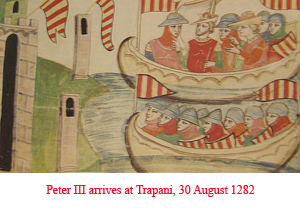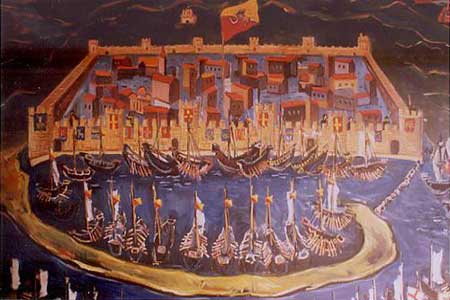The Sicilians were divided as to whether or not to call on
Peter III for help in their fight against
Charles of Anjou.
On the 27th of April, Palermo sent a messenger to Peter
asking for support, but the general parliament later called at Messina
rejected any foreign intervention, hoping to reach an accommodation with
Rome. By August, after the  announcement that the pope supported Charles's ownership of Sicily, the
Sicilians realized they needed the help of Aragon. Undoubtedly, the
Aragonese queen's membership in the Hohenstaufen family made the decision
to accept another foreign ruler more palatable. Furthermore, a
contingent of Catalans were in Messina for several weeks helping to
defend the city, which probably reinforced the view that they were
allies who could be relied on to fight. In August, Palermo sent 2
lenys to
Collo to ask Peter to come to
Sicily and receive the crown.
This apparently
was done without the advice of Messina, but by that
time the general population had resigned itself to being ruled by the Crown of
Aragon.
announcement that the pope supported Charles's ownership of Sicily, the
Sicilians realized they needed the help of Aragon. Undoubtedly, the
Aragonese queen's membership in the Hohenstaufen family made the decision
to accept another foreign ruler more palatable. Furthermore, a
contingent of Catalans were in Messina for several weeks helping to
defend the city, which probably reinforced the view that they were
allies who could be relied on to fight. In August, Palermo sent 2
lenys to
Collo to ask Peter to come to
Sicily and receive the crown.
This apparently
was done without the advice of Messina, but by that
time the general population had resigned itself to being ruled by the Crown of
Aragon.
In the chronicles, Peter is portrayed as surprised and affecting an air of concern as to whether or not to proceed. According to Muntaner, the arrival of two more galleys from Palermo and Messina with black sails, followed by the urging of a council of his barons moved Peter to act. Finally, on the last day of August Peter crossed over with his fleet to Trapani. Moving swiftly to Palermo, he was proclaimed the king of Sicily on September 4th. The exact size of Aragonese-Catalan force is unclear, but it probably had between 20 and 30 galleys, plus assorted smaller vessels.
Immediately after assuming the
 title of king, Peter sent a message to Charles at Messina
(siege of Messina right) stating his
claim to the island and demanding the French leave. Charles delayed his
answer and attempted to force Messina to surrender before news of the
Aragonese intervention could reach the beleaguered city. By September
17th, news of Peter's landing reached the city through a Genoese
merchant. Charles realized
that in the face of such a formidable force in hostile territory he would
eventually have to vacate the island, though he announced that he reserved
the right to return. Charles
evacuated slowly from Messina to Reggio across the Straits and apparently
had not counted on Peter advancing while Charles negotiated with him. His
leisurely retreat cost him, for in late September an advance party of
almugavars
caught his rear guard on the beach, slaughtering over 500 French knights, burning several ships and capturing significant
baggage and stores in the process. According
to Muntaner, the almugavars also burned many captured Angevin ships held
in the shipyard of San Salvador, depriving the Aragonese-Catalan fleet of
a valuable resource. Despite this setback, Peter entered Messina on
October 2nd to the accolades of general population.
title of king, Peter sent a message to Charles at Messina
(siege of Messina right) stating his
claim to the island and demanding the French leave. Charles delayed his
answer and attempted to force Messina to surrender before news of the
Aragonese intervention could reach the beleaguered city. By September
17th, news of Peter's landing reached the city through a Genoese
merchant. Charles realized
that in the face of such a formidable force in hostile territory he would
eventually have to vacate the island, though he announced that he reserved
the right to return. Charles
evacuated slowly from Messina to Reggio across the Straits and apparently
had not counted on Peter advancing while Charles negotiated with him. His
leisurely retreat cost him, for in late September an advance party of
almugavars
caught his rear guard on the beach, slaughtering over 500 French knights, burning several ships and capturing significant
baggage and stores in the process. According
to Muntaner, the almugavars also burned many captured Angevin ships held
in the shipyard of San Salvador, depriving the Aragonese-Catalan fleet of
a valuable resource. Despite this setback, Peter entered Messina on
October 2nd to the accolades of general population.


